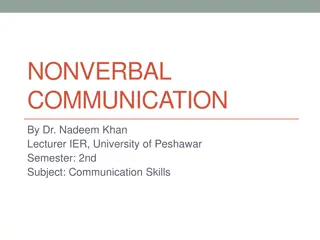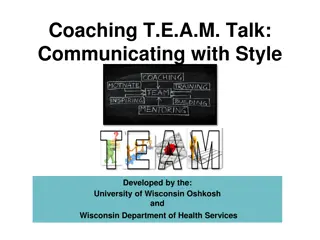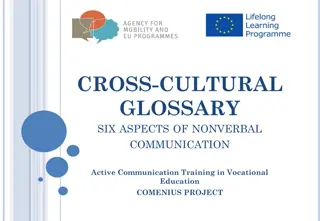College Transition Planning for Students with Learning Differences
Explore transition planning for students with learning differences like dyslexia, dyscalculia, dysgraphia, auditory and visual processing disorders, and nonverbal learning disabilities. Understand executive functioning challenges and characteristics of ADHD in educational settings.
5 views • 37 slides
Mastering Communication Skills: Essential Techniques
Enhance your communication skills through understanding types of communication, practicing the POP technique, and using verbal and nonverbal cues effectively. Improve your ability to convey messages clearly and make a positive impact.
1 views • 22 slides
Secondary Education
Communication is crucial in establishing relationships, sharing ideas, and managing teams. Verbal, nonverbal, written, and visual communication play vital roles in conveying information effectively. Understanding these communication types helps in building strong connections and enhancing collaborat
0 views • 19 slides
Impact of Communication Styles on Counseling and Social Work in Multicultural Settings
Exploring the influence of communication styles on counseling and social work in diverse cultural contexts, this study delves into the nuances of verbal and nonverbal communication, including proxemics, kinesics, and paralanguage. It highlights the importance of adapting interventions to align with
0 views • 18 slides
Section 2: Understanding Myself and Others
Explore the nuances of passive, aggressive, and assertive communication styles. Learn how to express your feelings effectively, use verbal and nonverbal communication skills, and enhance your overall communication abilities. Engage in interactive activities to improve your communication techniques a
3 views • 71 slides
Person-Centered Thinking in Direct Care Services
Providing Person-Centered Care is essential, especially during challenging times like COVID-19. This training focuses on understanding residents' needs, using behavioral and nonverbal indicators to improve care quality, and embracing a strength-based approach. Learn about Person-Centered Thinking, C
0 views • 24 slides
Understanding Modes of Communication and Verbal Messages
Communication occurs through verbal and nonverbal modes, with messages having denotative and connotative meanings. Verbal messages vary in directness, affecting the effectiveness of communication. Indirect messages offer advantages such as politeness and avoiding offense, but can also lead to misund
0 views • 64 slides
Understanding Body Language: A Comprehensive Guide
Body language is a form of nonverbal communication that involves physical behaviors to convey information. This includes facial expressions, body posture, gestures, eye movement, touch, and use of space. Understanding and interpreting body language involves analyzing aspects like eye contact, facial
1 views • 15 slides
Understanding Family Sculpting in Therapy
Family sculpting is a unique form of family therapy where trained therapists use psychodrama techniques to explore and address deep family dynamics. Through verbal and nonverbal expressions, family members are placed in scenes that reflect their roles and attitudes within the group. The sculptor, ty
0 views • 14 slides
Understanding the Importance of Nonverbal Communication in Communication Skills
Nonverbal communication plays a crucial role in conveying messages and signals through platforms like eye contact, facial expressions, gestures, posture, and spatial distance. It includes appearance, body language, silence, time, and space. This form of communication can significantly impact the rec
0 views • 16 slides
Understanding Microaggressions in Everyday Interactions
Unpacking the concept of microaggressions through the lens of Yolanda Flores Niemann's keynote slides, we delve into the manifestations, types, and impacts of these subtle yet harmful behaviors. From verbal and nonverbal acts to environmental displays, microassaults are explored as deliberate action
0 views • 56 slides
Understanding Emotional Intelligence: Key Principles and Skills
Emotional intelligence, as presented by David Taylor, is crucial in perceiving, understanding, and managing emotions in oneself and others. It plays a vital role in professional and personal relationships by enhancing emotional awareness, recognition, and management. The principles of emotional inte
1 views • 22 slides
Enhancing Cross-Cultural Communication: Strategies for Success
Explore the impact of cultural and linguistic differences on communication in this webinar, focusing on preparing English language learners to communicate effectively across cultures. Learn about a cross-cultural incident and discover elements of culture and communication, including nonverbal cues.
0 views • 37 slides
Mastering Communication Styles for Effective Teamwork
Enhance your communication skills by identifying and adapting to different styles within your team. This program developed by the University of Wisconsin Oshkosh and Wisconsin Department of Health Services focuses on improving verbal and nonverbal communication to foster successful teamwork. Learn t
0 views • 12 slides
Cross-Cultural Aspects of Nonverbal Communication in Vocational Education
Explore the six aspects of nonverbal communication in vocational education across partner countries like Poland, Turkey, France, Romania, Bulgaria, Italy, and Croatia. Discover similarities and differences in appearance, posture, haptics, gestures, eye contact, and proxemics. Delve into cultural pra
1 views • 33 slides
Building Self-Confidence in Healthcare Workplace
Discover the power of self-confidence in healthcare with tips to boost skills, communicate effectively, and embrace new challenges. Learn how confidence is a skill that can be developed through practice and awareness, leading to workplace pride and positive contributions. Explore the impact of nonve
1 views • 27 slides
Enhancing Communication Skills with T.E.A.M. Talk
Explore T.E.A.M. Talk, a communication style program developed by the University of Wisconsin Oshkosh, aimed at improving verbal and nonverbal communication skills, understanding different communication styles, and adapting strategies for successful team collaboration. Engage in activities to analyz
0 views • 9 slides
Mastering Effective Communication Skills in Daily Life
Enhance your communication skills with insights from Unit 5 Communication. Learn about different types of communication, speaking skills, effective communication strategies, assertiveness, and more. Understand the nuances of verbal, nonverbal, and paralanguage communication to convey your message cl
0 views • 52 slides
Importance of Nonverbal Communication in Healthcare
Understanding and utilizing nonverbal communication plays a crucial role in effective healthcare delivery. This presentation explores the significance of soft skills, including nonverbal communication, in healthcare settings. It covers different types of nonverbal cues, activities to enhance underst
0 views • 28 slides
Mastering High-Touch Relationships in the Digital Era
Discover effective communication strategies for maintaining high-touch relationships in today's high-tech world. Explore the importance of communication basics, decoding text talk, understanding verbal and nonverbal cues online, and knowing when to call instead of email or text. Learn how to craft r
0 views • 12 slides
Understanding Human Relations and Communication
Human relations pertain to relationships among individuals, whether formal or informal, emotional or unemotional. Effective communication involves conveying thoughts and understanding others. It includes verbal and nonverbal aspects, with nonverbal communication playing a significant role in message
0 views • 57 slides
Understanding Children's Qualities and Development
This presentation provides insights into the qualities and development of children, emphasizing the importance of nonverbal communication, attachment, temperament, and regulation of cognition, emotions, and behavior. It covers a range of topics from how children experience the world to their individ
0 views • 16 slides
Mastering Nonverbal and Verbal Communication for Effective Leadership
Discover the crucial X and Y factors of nonverbal and verbal communication for leaders through active listening, message delivery, and nonverbal cues. Explore how poor communication leads to stress and learn techniques like reflective styles, Socratic questioning, and giving concise messages. Enhanc
0 views • 30 slides
Instructional Training for Public Health Professionals Module 4
This module focuses on enhancing instructional and delivery skills for public health professionals. Participants will learn to identify factors for effective delivery, recognize positive presentation skills, and describe tools used in instructional settings. Topics covered include instructor aptitud
0 views • 23 slides
Handling Conflict During an Animal Health Emergency
When faced with conflict situations during an animal health emergency, understanding different backgrounds, values, and beliefs is crucial. Just-in-time training on conflict resolution can help deal with angry, fearful, or non-cooperative individuals. Before a site visit, learning about the owner, t
0 views • 14 slides
Unlock Your Confidence: Tips for Presentations and Interviews
Empower yourself with strategies to boost confidence during presentations and interviews. Learn about the impact of nonverbal communication, effective preparation techniques, and the power of body language. Discover how power poses and feeling powerful can enhance your performance. Gain insights on
0 views • 11 slides
Enhancing Social Skills & Communication: Insights from the National Autistic Society
Explore the intricacies of social skills, nonverbal communication, conversations, and socializing from materials sourced from the National Autistic Society website. Delve into social skill development with a focus on understanding and improving interactions.
0 views • 29 slides
Understanding Reflective Listening Techniques in Motivational Counseling Training
Reflective listening involves active listening, observing, and interpreting verbal and nonverbal cues to understand the speaker's thoughts and feelings. It includes levels of reflection such as simple rephrasing, complex paraphrasing, reflection of feeling, double-sided reflection, and summarizing t
0 views • 15 slides
Exploring Silent Languages: Sign Language, Body Language, and Nonverbal Communication
Delve into the world of silent languages through an introduction to linguistic anthropology in Chapter 5. Explore the transmission of messages without spoken words, the intricacies of sign languages, gestures, body language, and nonverbal communication. Discover the unique syntax and complexity of s
0 views • 20 slides
Effective Communication Strategies for Fire and EMS Company Officers
This presentation focuses on various types of communication strategies essential for success in the fire and EMS industry. It covers verbal and nonverbal communication, organizational obstacles, and the importance of written communication for company officers. The content emphasizes the significance
0 views • 18 slides
Communication Exam Review and Tips
Understanding the key concepts of communication such as barriers, cultural context, nonverbal communication, and critical listening skills is crucial for effective communication. This content covers important topics from developing professional presence to managing the communication process. It also
0 views • 26 slides
The Art of Communication: Expressing Yourself Effectively
Exploring the essence of communication, this content delves into various aspects such as different ways to communicate, interpreting quotes on communication, understanding cultural communication methods, and the significance of effective communication strategies. Readers are invited to reflect on pe
1 views • 16 slides































